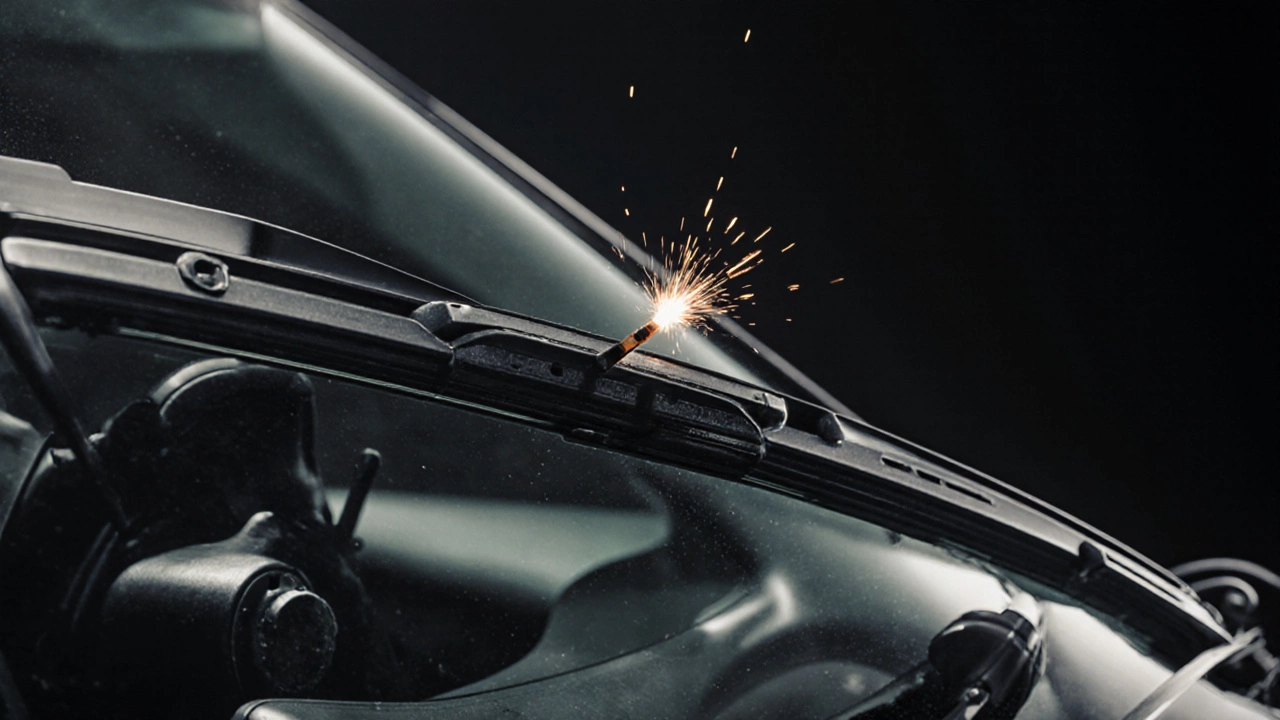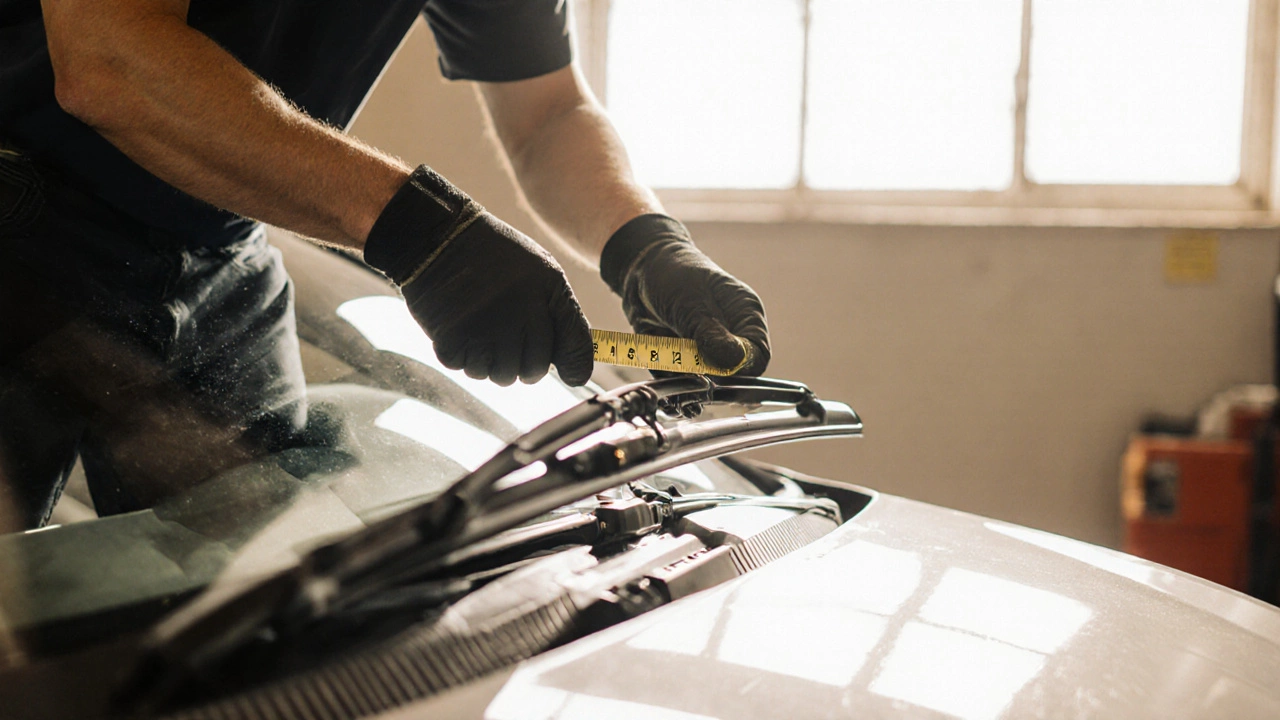 Oct, 15 2025
Oct, 15 2025
Wiper Blade Size Checker
Check Your Wiper Blade Size
Enter your blade's length to see if it matches your vehicle's specifications and avoid costly damage.
Ever popped a wiper blade onto a car and noticed the rain still dancing on the glass? That happens when the wiper blade size doesn't match the windshield. The wrong fit can turn a simple rain‑clearing task into a noisy, streaky nightmare - and it can even damage the wiper system.
Quick Takeaways
- Using a blade that’s too short leaves blind spots; a blade too long can scrape the glass.
- Mismatched size causes excess vibration, noisy operation, and premature wear.
- Critical components at risk: blade arm, wiper motor, and the windshield itself.
- Measure correctly and consult the vehicle’s spec sheet before buying.
- Follow simple installation steps to avoid costly repairs.
What a Wiper Blade is and why size matters
A wiper blade consists of a Rubber Strip attached to a Blade Arm. The arm holds the strip at a specific angle, and the strip sweeps across the Vehicle Windshield. Blade length is measured in inches (or millimetres) and varies by vehicle make, model, and glass curvature.
Two key attributes define a blade’s fit:
- Length - the overall distance from tip to tip, typically 16″, 18″, 20″, 22″ or 24″ for most passenger cars.
- Attachment type - common hooks include "hook‑type", "pin‑type" and "bayonet".
If either attribute doesn’t align with the car’s Windshield Wiper design, performance suffers.
Symptoms of the wrong size blade
Here’s what you’ll likely notice when the blade is too short:
- Uncleared corners - rain pools at the top‑corner or lower‑edge.
- Streaks remain after each sweep.
And when the blade is too long:
- The extra length contacts the glass edge, creating a high‑pitched squeal.
- Repeated scraping can chip the glass or wear the rubber strip early.
- Excess force may bend the blade arm or put extra load on the wiper motor.
Both scenarios increase vibration, making the whole system feel loose and noisy.

How a mismatched blade can damage your wiper system
Vehicle manufacturers engineer the Blade Arm with precise pivot points. A blade that’s longer than intended pushes the arm past its designed travel range, which can:
- Flex the arm, causing it to snap after a few uses.
- Overload the Wiper Motor, leading to overheating and shortened motor life.
- Stress the Rain Sensor (on modern cars) because water droplets don’t clear evenly, confusing the sensor’s readings.
Conversely, a blade that’s too short doesn’t engage the full sweep arc, meaning the motor runs longer to compensate, which can waste fuel and increase wear.
Choosing the right size - a step‑by‑step guide
- Locate the vehicle’s specification sheet - usually in the owner’s manual or on the manufacturer’s website. Look for “wiper blade length” and “attachment type”.
- Measure the existing blade. Place a ruler along the rubber strip from tip to tip; note the length in inches.
- Verify the curvature. Some cars (e.g., SUVs) use “beam” blades that conform to a curved windshield; others use “conventional” blades with a flatter shape.
- Match the attachment. Pull the old blade off; observe whether it’s a hook, pin, or bayonet. Buy a replacement with the same connector.
- Cross‑check with a reputable parts catalog (OEM vs. aftermarket). OEM blades guarantee exact fit; quality aftermarket blades can be cheaper but must list the same dimensions.
When in doubt, many auto parts stores will measure the blade for you - a free service worth using.
Installation tips to avoid common mistakes
- Clean the windshield first. Dust or debris can cause the new rubber strip to smear.
- Secure the blade arm before attaching the rubber strip. A loose arm can cause the strip to wobble.
- Apply slight pressure until you hear a “click” - that confirms the attachment is locked.
- Test the wipers at low speed. If you hear a squeal, re‑inspect the blade length and arm angle.
- Replace both blades at the same time. Even‑wearing blades prevent uneven pressure on the motor.

Comparison: Correct Size vs. Wrong Size Blade
| Aspect | Correct Size | Wrong Size (Too Short) | Wrong Size (Too Long) |
|---|---|---|---|
| Wiping Coverage | Full windshield sweep, no blind spots | Corner pooling, reduced visibility | Glass edge contact, potential scratching |
| Noise Level | Quiet, smooth operation | Minor flutter, but usually acceptable | Loud squeal, vibration |
| Blade Wear | Even wear, lasts 6‑12 months | Premature rubber cracking | Rapid wear from edge abrasion |
| Impact on Arm | Normal stress | Minimal stress | Arm flexing or snapping |
| Motor Load | Standard power draw | Slightly longer run time | Higher torque, possible overheating |
Pre‑purchase checklist
- Confirm blade length (e.g., 16″ front, 24″ rear).
- Identify attachment type (hook, pin, bayonet).
- Choose blade style matching windshield curvature (beam vs. conventional).
- Verify OEM part number if you want a factory‑exact replacement.
- Read reviews for durability - look for “no squeal” and “long‑lasting rubber”.
Frequently Asked Questions
Can I use a longer blade on a smaller windshield?
No. A longer blade will hit the glass edge, creating a squeal and risking scratches or arm damage. Stick to the length recommended by the manufacturer.
What’s the difference between beam and conventional blades?
Beam blades have a single, flexible frame that conforms to curved windshields, providing even pressure. Conventional blades use a separate arm with a spring; they’re cheaper but may leave streaks on highly curved glass.
How often should I replace my wiper blades?
Most manufacturers recommend replacement every 6‑12 months, or sooner if you notice streaking, chatter, or a squeal during operation.
Will a wrong‑size blade affect my rain sensor?
Yes. If water isn’t cleared evenly, the sensor may think it’s still raining and keep the wipers running longer than needed.
Can I mix OEM and aftermarket blades?
Mixing is possible if both match the exact size and attachment type, but using identical brands on both sides ensures balanced performance.
Choosing the right wiper blade size isn’t just about clear vision; it protects the whole wiper assembly from premature wear and costly repairs. Measure, verify, and install correctly - and rain will never be a surprise again.